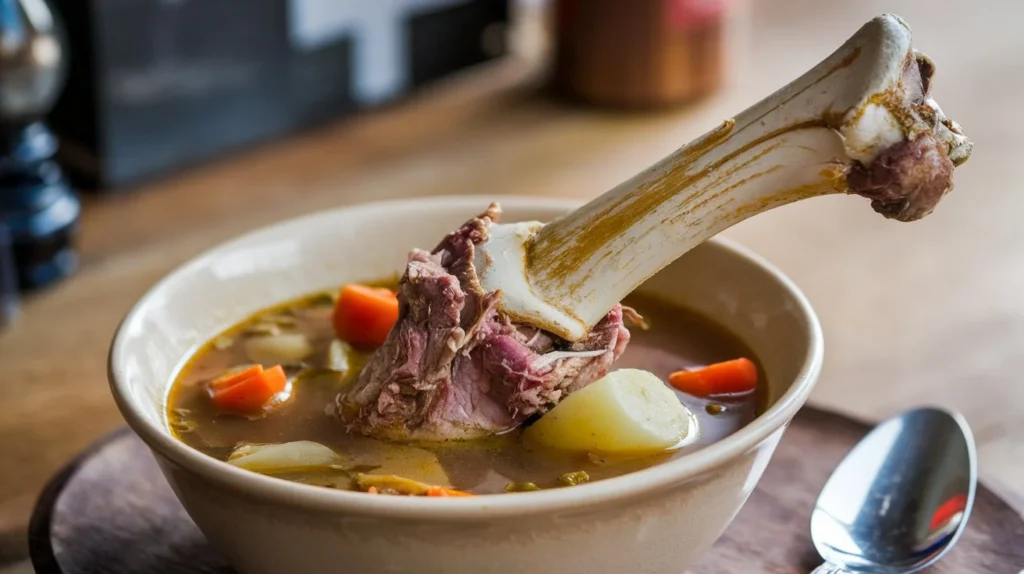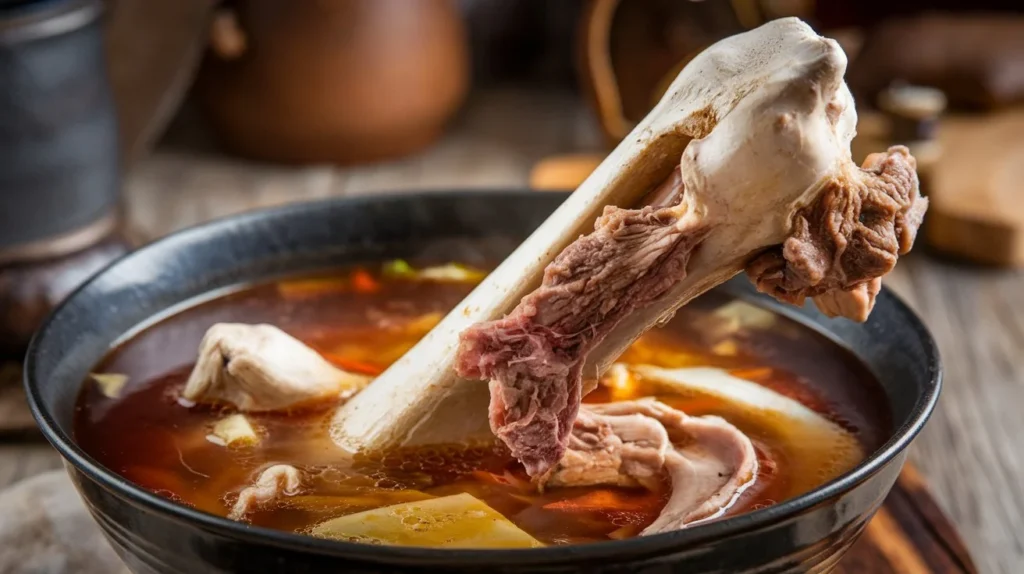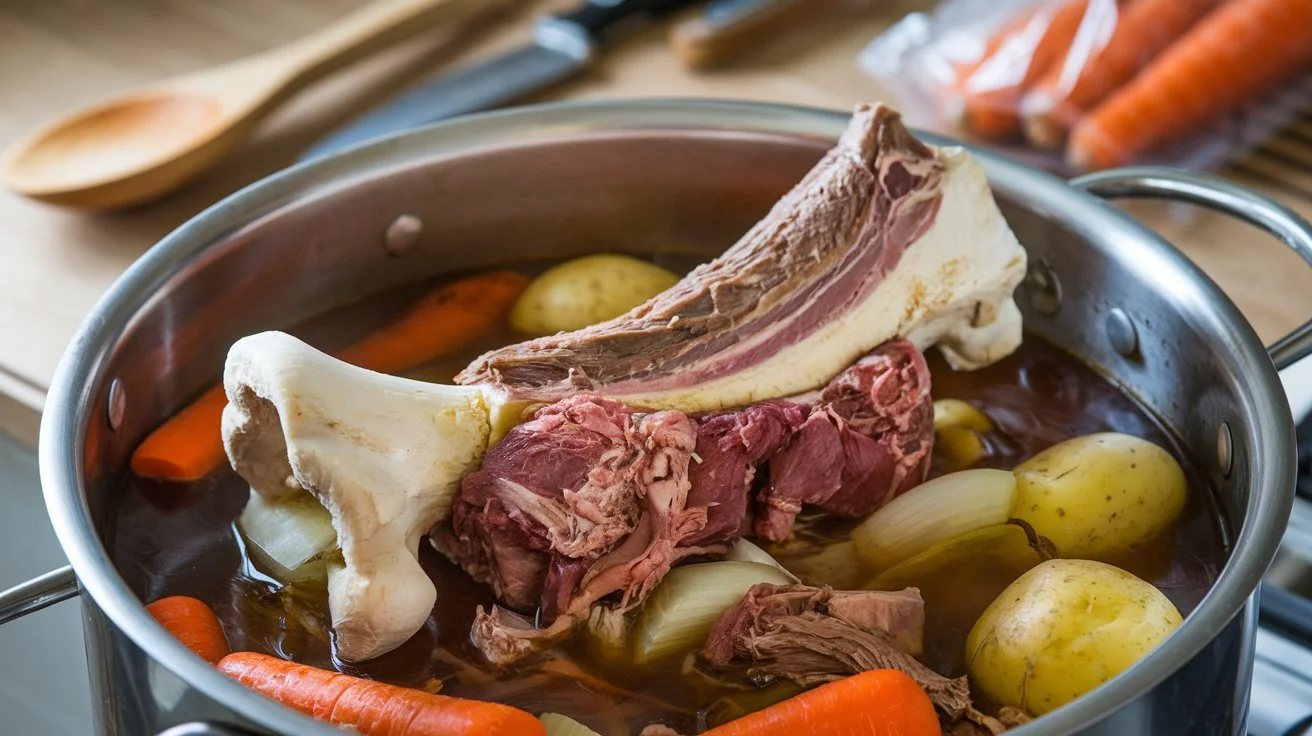Introduction
If you’ve ever wondered what makes certain soups and broths taste so rich and flavorful, the answer may lie in the humble soup bone. These kitchen staples have been used for generations to create hearty meals that nourish both the body and soul. But soup bones aren’t just about taste — they’re also a nutritional powerhouse loaded with essential vitamins, minerals, and collagen.
In this guide, you’ll learn everything there is to know about soup bones. From selecting the right bones and preparing them for cooking to unlocking their health benefits and mastering classic recipes, you’ll have all the tools you need to make restaurant-quality broths right in your kitchen. Whether you’re a seasoned chef or a kitchen novice, this guide has you covered.
So, let’s dive in and discover the secrets of soup bones that chefs and home cooks around the world swear by.
Introduction to Soup Bones
Introduction to Soup
If you’re new to cooking with soup bones, you’re in for a treat. These bones aren’t just kitchen scraps — they’re culinary treasures! Often sourced from beef, chicken, lamb, or even fish, soup bones are packed with flavors that can’t be replicated with powdered broth or store-bought stock. When simmered slowly, these bones release essential nutrients like collagen and gelatin, which not only create a silky texture but also offer numerous health benefits.
Soup bones are the foundation for bone broths, stews, and hearty soups. Whether you’re crafting a homemade chicken soup to fight off a cold or preparing a rich beef bone broth to boost your health, soup bones are at the heart of it all. But before you grab any random bone, it’s essential to know which ones work best and how to prepare them properly.
Understanding
So, what exactly is a soup bone? At its core, it’s any bone with enough meat, connective tissue, or marrow to infuse a liquid with flavor and nutrients. Unlike boneless cuts of meat, these bones are prized for their ability to create rich, savory broths that can be used in soups, sauces, and gravies.
Soup bones typically come from large animals like cows, chickens, and lambs. They may include shank bones, oxtails, neck bones, or joint bones. The presence of marrow in these bones makes them especially valuable for making bone broth, as it adds a luxurious, silky mouthfeel. Moreover, the slow cooking process extracts collagen, transforming it into gelatin, which not only enhances the texture of soups but also provides health benefits for joints, skin, and gut health.
You may wonder if any bone can be used as a soup bone. While technically true, certain bones produce better results. For instance, beef shank bones are preferred for their marrow content, while chicken feet are renowned for their gelatin-producing abilities. Knowing which bones to use can significantly impact the quality of your broth.
Types of Soup Bones
Different types of soup bones offer distinct flavors and textures. Understanding the difference between them can help you choose the right one for your recipe. Here are the most common types:
Beef Bones
- Shank Bones: These are some of the best soup bones due to their high marrow content. Shank bones produce a rich, meaty flavor.
- Oxtails: Packed with collagen and connective tissue, oxtails create a broth that’s thick and luxurious.
- Knuckle Bones: These bones contain a lot of cartilage, making them perfect for producing gelatin-rich broths.
Chicken Bones
- Chicken Carcasses: After removing the meat, the carcass can be simmered to extract flavor for broths.
- Chicken Feet: Surprisingly, chicken feet are some of the best soup bones for producing gelatin, thanks to their high cartilage content.
- Neck Bones: These small, bony parts of the chicken are packed with flavor and are often used in combination with other bones.
ue role in the kitchen. For a rich, hearty broth, opt for beef shank bones or oxtails. If you prefer a lighter, more delicate broth, chicken carcasses and fish bones are ideal.
Nutritional and Health Benefits of Soup Bones
Nutritional Benefits
Soup bones are nutritional powerhouses that offer far more than just flavor. When simmered over low heat for an extended period, they release a treasure trove of essential nutrients that promote overall health and well-being.
One of the most notable components of soup bones is collagen, a structural protein that transforms into gelatin when cooked. This gelatin gives soups and broths a smooth, silky texture while also supporting joint health, improving skin elasticity, and enhancing gut health. The slow cooking process breaks down the connective tissues, releasing valuable amino acids like glycine, proline, and glutamine, which aid digestion, promote better sleep, and reduce inflammation.
Soup bones are also rich in key minerals like calcium, phosphorus, magnesium, and potassium. These minerals are essential for maintaining strong bones, healthy teeth, and proper muscle function. The longer the bones are cooked, the more nutrients are extracted, creating a nutrient-dense broth that nourishes the body from within. This is why slow-cooking soup bones is a must for extracting maximum nutritional value.
If you’re looking for a way to naturally boost your immune system, improve your digestive health, and support your body’s natural repair processes, incorporating soup bones into your cooking routine is a smart choice. With every spoonful, you’re getting a concentrated dose of essential nutrients your body craves.
Cooking, Preparation, and Storage

How to Choose Quality Soup Bones
When it comes to making the perfect soup bone broth, quality matters. Choosing high-quality bones ensures richer flavor, better texture, and more nutritional benefits.
For the best results, look for bones from organic, pasture-raised, or grass-fed animals. These bones are free from antibiotics and hormones, making them healthier and more nutrient-dense. When shopping at a butcher, farmers’ market, or grocery store, ask for fresh cuts like beef shanks, knuckles, oxtails, or chicken feet. Look for bones with a healthy amount of marrow and connective tissue. Fresh bones should have a clean, meaty aroma and a natural, vibrant color, not a dull or grayish tone.
Preparing Soup for Cooking
Before you toss your soup bones into a pot, a bit of prep work is essential. Proper preparation ensures maximum flavor and a clean, clear broth. Here’s how to do it right:
- Washing the Bones: Rinse your soup bones thoroughly under cold water to remove any residual blood, bits of meat, or impurities. This step reduces scum during cooking.
- Blanching: To achieve a clear, clean broth, blanch your bones in boiling water for 10-15 minutes. This removes excess fat and impurities that can cause the broth to become cloudy.
- Roasting: Roasting soup bones at 400°F (200°C) for 30-40 minutes caramelizes the surface, adding depth and a rich umami flavor to your broth. Beef and lamb bones, in particular, benefit from roasting.
Common Mistakes to Avoid
- Skipping the blanching step: This can lead to cloudy broth and unwanted “off” flavors.
- Overcrowding the roasting pan: If bones are too close, they’ll steam instead of roast, resulting in less flavor.
- Boiling instead of simmering: Always simmer broth gently to avoid a cloudy, greasy appearance.
By following these steps, you’ll end up with a clear, flavorful broth that’s packed with nutrients and delicious to the last drop.
Classic Soup
Making homemade soup bone broth is easier than you think. Here’s a step-by-step guide to crafting the perfect broth:
Classic Bone Broth Recipe
- Ingredients: Beef bones (shank, knuckles, oxtails), filtered water, onions, garlic, carrots, celery, bay leaves, peppercorns, and apple cider vinegar.
- Preparation: Wash, blanch, and roast the bones following the earlier steps.
- Cooking: Add roasted bones and vegetables to a pot, cover with water, and add apple cider vinegar (to help draw out minerals). Bring to a boil, then reduce to a low simmer for 12-24 hours.
- Straining: Strain the broth to remove bones, vegetables, and impurities. Chill and remove solidified fat before use.
Recipe Variations
- Beef Bone Soup: Uses roasted beef bones and hearty vegetables to create a rich, comforting soup.
- Chicken Bone Soup: Simmer chicken bones (carcass, neck, or feet) with garlic, onions, and fresh herbs for a lighter, golden broth.
- Vegetable-Infused Bone Broth: Add turmeric, ginger, and fresh herbs for a wellness-boosting broth with anti-inflammatory benefits.
Each recipe can be adapted to fit your taste and dietary needs, but the basic process stays the same: slow cooking soup bones to release their maximum flavor and nutrients.
International Dishes Featuring Soup Bones
Soup bones aren’t just a Western staple — they play a vital role in international cuisine. Across the globe, cultures have developed iconic dishes that rely on the depth of flavor only bones can provide.
Korean Seolleongtang
This traditional Korean soup uses beef leg bones and is simmered for 15+ hours to create a rich, milky-white broth. It’s served hot with rice, green onions, and salt added to taste.
Vietnamese Pho
Pho, the beloved Vietnamese dish, relies on beef bones to create its signature broth. Spices like star anise, cloves, and cinnamon infuse the broth with aromatic flavor.
Japanese Ramen
Ramen broths are made with pork or chicken bones simmered for 12+ hours to achieve a creamy, full-bodied flavor. The slow-simmering process creates the iconic “cloudy” broth texture.
These dishes highlight the universal appeal of soup bones as the key to unforgettable soups. Whether you prefer the light elegance of pho or the rich depth of seolleongtang, you’ll notice that the power of bones is at the heart of each recipe.
Sustainability, Cost, and Cultural Relevance
Vegetarian Alternatives to Bone Broth
For those seeking plant-based alternatives to traditional soup bone broth, there are plenty of ways to replicate its taste, texture, and nutritional value. Instead of animal bones, you can use vegetables, mushrooms, seaweed, and other nutrient-dense ingredients.
Vegetables like carrots, onions, garlic, celery, and leeks provide a base of umami flavor. Mushrooms, especially shiitake and porcini, offer rich, meaty notes. Seaweed varieties like kombu and wakame are essential for adding depth, along with miso for an extra umami punch. By slow-cooking these ingredients for 6-12 hours, you’ll achieve a savory, mineral-rich broth that rivals traditional bone broth.
Some popular plant-based “bone broth” recipes include vegetable-mushroom broth, seaweed-infused broth, and miso-infused broths, all of which provide gut-supporting benefits similar to animal-based versions.
Environmental Impact of Using Soup Bones
Using soup bones in cooking is one of the simplest ways to promote zero-waste living. Instead of discarding bones from cuts of meat, they are repurposed into flavorful broths and soups. This practice reduces food waste and promotes a more sustainable approach to cooking.
When bones are used to make broth, every part of the animal is utilized. In fact, bones that would have otherwise been discarded are transformed into nutrient-rich food. By reusing bones, you not only reduce waste but also extend the life cycle of each ingredient.
From a sustainability standpoint, choosing organic, grass-fed, and pasture-raised bones is crucial. Ethical sourcing ensures that animals are raised humanely, and it also reduces the environmental impact of large-scale, industrial farming. Supporting local butchers, farmers’ markets, and sustainable meat suppliers can further reduce the carbon footprint associated with meat production.
Economic Benefits of Cooking with Soup Bones
Cooking with soup bones isn’t just sustainable — it’s also incredibly economical. For a fraction of the cost of store-bought broth, you can make large batches of rich, homemade bone broth that’s healthier and more flavorful.
Because soup bones are often viewed as “leftovers” by butchers, they are usually inexpensive to purchase. Even premium cuts like beef shanks, chicken carcasses, and oxtails are affordable compared to buying pre-packaged broths.
Cultural Significance of Soup Bones in Various Cuisines
The use of soup bones in cooking transcends cultural boundaries. Across the world, traditional cuisines have relied on bones to create flavor-packed broths that serve as the heart of many iconic dishes.
In Asia, Korean Seolleongtang (milky bone broth) and Vietnamese Pho (fragrant beef broth) are beloved staples. European kitchens feature dishes like French Pot-au-feu and Italian Brodo, while in African cuisine, goat or lamb bones are often used to create rich, hearty soups and stews.
Many of these cultural dishes are considered healing foods, with bone broths used as traditional remedies for colds, flu, and digestive issues. It’s no surprise that the tradition of cooking with soup bones has been passed down for generations. From Europe to Africa to Asia, these practices highlight the resourcefulness of home cooks who know how to extract every ounce of flavor from a humble bone.
Debunking Myths About Soup Bones and Bone Broth
There are plenty of myths surrounding soup bones and bone broth. Let’s set the record straight.
Myth 1: Bone broth is a miracle “detox” drink
While bone broth is healthy, it is not a magical detox solution. Bone broth supports digestion, promotes gut health, and provides essential amino acids, but it doesn’t “flush out toxins” from your body.
Myth 2: Any bone can make broth
Technically, this is true, but not all bones will produce the same results. Beef knuckles, oxtails, and shank bones are ideal because they contain marrow and collagen, which add flavor and nutrients.
Myth 3: Bone broth is just stock
This is false. Bone broth is simmered much longer than stock, sometimes up to 24 hours. This extended cooking time releases more collagen and amino acids, giving bone broth its health benefits.
Myth 4: Bone broth is expensive to make
On the contrary, bone broth is cost-effective. By using leftover soup bones and vegetable scraps, you can make large batches of broth for pennies on the dollar.

Frequently Asked Questions About Soup Bones
What are soup bones used for?
Soup bones are used to create broths, soups, and stews with deep, rich flavors. They release collagen, minerals, and amino acids that improve the taste, texture, and nutrition of the final dish.
What’s the difference between soup bones and marrow bones?
Soup bones often include meat, connective tissue, and joints, while marrow bones are hollow bones filled with marrow. Both add flavor, but marrow bones contribute more richness and creaminess to the broth.
Can I reuse soup bones after making broth?
Yes, but the flavor and nutrients will diminish after the first batch. Some cooks reuse bones once to make a “weaker” broth called a remouillage, but most of the collagen is extracted during the first simmer.
How do I know when my soup bones are fully cooked?
When the broth is rich, gelatinous, and aromatic, your soup bones have done their job. The bones will become soft and brittle after cooking for 12-24 hours.
How long should I cook soup bones for optimal flavor?
Cooking times vary based on the type of bone. Beef bones should simmer for 12-24 hours, while chicken bones require 6-8 hours. The longer you cook, the richer the broth.
Can I use frozen soup bones for broth?
Absolutely! Frozen bones work just as well as fresh. Simply thaw them in cold water or use them straight from the freezer, but expect the cooking time to increase slightly.
Conclusion
Soup bones are a culinary treasure that offers both flavor and nutrition. From rich bone broths to international delicacies, soup bones have played a vital role in kitchens worldwide for centuries. They promote sustainability, reduce food waste, and provide a cost-effective way to make healthy, hearty meals.
By learning to cook with soup bones, you’re not just improving your cooking skills — you’re also embracing a sustainable, health-conscious approach to food. So, the next time you’re at the butcher, ask for some soup bones, and turn them into flavorful, nutrient-dense broths, stews, and soups that will nourish your body and soul.








